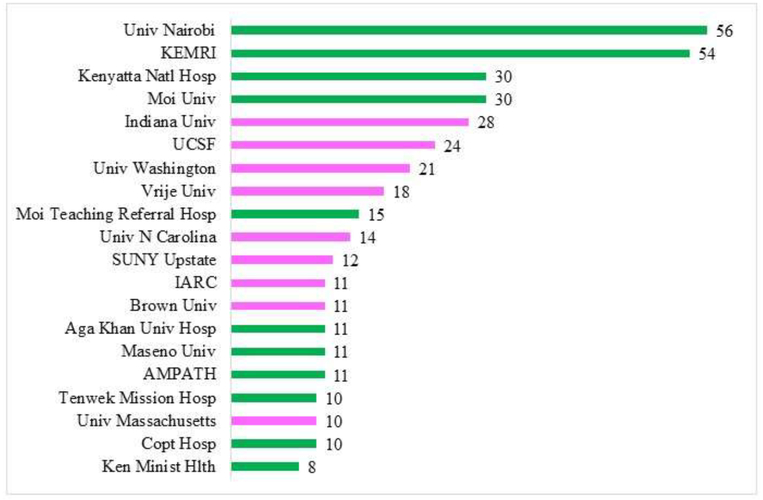Abstract
AIM:
Cancer research is essential to the development and implementation of effective control strategies and interventions. In Kenya, cancer is the third leading cause of death. Country specific research conducted by local and international investigators can inform a national plan to address local needs across the cancer care continuum. This analysis aims to provide information about the trends and types of cancer research collaborations, funding, and outputs from 2007–2017, to understand gaps and opportunities to strengthen Kenya-led cancer research capacity.
METHODS:
This analysis included 243 studies from a previously published phase 1 scoping review of oncology research conducted and published in Kenya from 2007–2017. The citation metadata was drawn from the Web of Science and PubMed and normalized in Microsoft Excel. Using Sci2, a series of bibliometric network analyses were conducted to identify funding patterns, collaborations between authors and institutions, and the types of cancer research conducted in Kenya. Gephi and Excel provided descriptive analyses and graphs of the network. The analyses are categorized into three themes: article production, collaboration, and research topics.
RESULTS:
The bibliometric analysis found 5 US-based government agencies are funding cancer research in Kenya. Kenya-Kenya institutional collaborations were most common, and half of authors with the most co-authored publications were from Kenya. The publication trend showed a gradual increase from 2011–2014 with a subsequent drop through 2017.
CONCLUSION and POLICY SUMMARY STATEMENT:
This study identifies the funders and most often published Kenyan authors and Kenyan-based institutions publishing oncology research in Kenya. It also identifies future areas to focus research and the importance of continuing to build the writing and publishing capacity on oncology research by Kenyans.
Keywords: Kenya, Africa, Neoplasms, Bibliometrics, Authorship
INTRODUCTION
Globally, after cardiovascular diseases, cancer is the second deadliest non-communicable disease, accounting for approximately 19.3 million cases and close to 10 million deaths in 2020 [1]. A large and growing proportion of the global burden of cancer mortality lies with lower income countries with less established healthcare systems [2]. The International Agency for Cancer Research estimates by 2040 a 96% increase in new cancer cases amongst countries in the low health development index (HDI) level and 65% for countries with a medium HDI [3]. Despite this burden, these impacted countries will only have access to about 5% of global resources devoted to cancer [4].
Kenya has a 2019 human development index score of 0.601 and is ranked 143 out of 190 countries [5]. In Kenya, there were approximately 42,116 new cases of cancer with a 27,092 deaths in 2020 [6]. In response to the growing cancer burden, the Kenyan Ministry of Health’s (MOH) mandate within the Kenya National Cancer Control Strategy (NCCS) 2017–2022 was to develop a national cancer research agenda. To support this mandate and the MOH’s efforts, a scoping review was conducted on oncology research conducted in Kenya and published from 2007 to 2017 [7]. Cancer research is essential to inform evidence-based cancer control strategies because it ensures that interventions and policies are based on locally generated evidence and are effective for the specific locale. The scoping review identified the number of studies, cancer sites studied, study designs used, geographic locations, and the funding sources used. It also highlighted current gaps in research capacity, types of cancers studied, and scientific focus which can inform the development of a future cancer research agenda for Kenya.
To further understand the types of active or completed research collaborations and identify research areas that need further investment, attention, and development, a bibliometric analysis of the scoping review results was conducted. The aim is to map the current networks between research funders, authors, and institutions, and to identify who is collaborating or partnering on cancer research in Kenya. In combination with the scoping review, these findings can inform decisions on future oncology research priority topics, gaps, and opportunities for future research funding and collaborations as well as for building and strengthening overall research capacity in Kenya.
METHODS
Data Source and Cleaning
The articles used in this study were those included in the scoping review of oncology research in Kenya and published from 2007 to 2017 [7]. This bibliometric analysis included 243 articles out of the 284 used in the 2017 scoping review. Due to the different content coverage of the Web of Science: Core Collection (WOS) database in comparison to the PubMed database, some articles were lost which resulted in a different final count of articles used in the bibliometric analysis versus in the scoping review. The articles analyzed in this study were identified by searching in the WOS and PubMed databases for each article individually by article title, and then the data was exported to Mendeley v1.19.6 (Elsevier) to remove the duplicate citations. The citation metadata of the 243 articles were downloaded, and to account for variations the funding source and author affiliation address fields were manually cleaned, and the names normalized in Microsoft Excel.
Bibliometric Analysis
Using the normalized data from WOS, the bibliometric analyses were conducted using the Science of Science Tool (https://sci2.cns.iu.edu/user/index.php) and visualized using Gephi (https://gephi.org/). Country information, extracted from the author affiliation address field, was loaded to Tableau (https://www.tableau.com/) to produce geographical maps. Research topics were based on each article’s major Medical Subject Heading (MeSH) terms. To obtain its MeSH terms, each included article was searched by PMID or article title in the PubMed/MEDLINE database. MeSH is the controlled vocabulary used to describe the disease, condition, topic, intervention, publication type, funding source, population, species, ages, and geography of articles published in journals indexed in MEDLINE. Each article was assigned a minimum of five major MeSH terms which describe the major focus of the article and are usually obtained from the title and/or abstract or statement of purpose [8]. The numbers of co-funded articles per funding agency were derived from the funding agencies data in WOS and PubMed/MEDLINE. All data used in these analyses were current as of November 13, 2020.
RESULTS
This bibliometric analysis describes research output and productivity, collaborations between authors, institutions, and funding agencies, and the major research topics published from 2007–2017 on cancer research conducted in Kenya. A total of 243 articles were included in these bibliometric analyses.
Article Characteristics
Of the 243 included articles, the majority 234 (97%) were primary research articles. The most articles (31) were published in the regional medical journal, East African Medical Journal and followed by PLoS One (18) and the International Journal on Cancer (15). The number of articles published was lowest in 2008 with 10 articles and peaked in 2014 at 36 articles. A steady increase in published articles was seen from 2011 to 2014 with publication output cresting in 2014 but has slowly declined since (see Supplemental Figure 1). The 2014–2017 time period accounts for 54% of the total number of articles during the specified time period. 2017 is likely a slight underestimate as articles were published after our searches were conducted in November 2017 for the scoping review.
Collaboration
Individual and Institutional Authorship
Figure 1 shows co-authorship by institutional affiliation from our dataset. At least 95% of the articles had at least one co-author from a university. Seventy percent of articles represented a collaboration between a Kenyan institution and a non-Kenyan institution, and 26% of articles had Kenya-only author affiliations (see Supplemental Figure 2).
Figure 1: Institutional Co-Authorships.
The green bars are Kenyan or African institutions and the pink bars are institutions from outside of the African region.
AMPATH = Academic Model Providing Access to Healthcare, USA/Kenya; Copt Hosp = Coptic Hospital; Hosp = Hospital; IARC = International Agency for Research on Cancer; KEMRI = Kenya Medical Research Institute; Ken Minist Hlth = Kenya Ministry of Health; SUNY Upstate = State University of New York Upstate, USA; Univ = University; UCSF = University of California San Francisco, USA; Univ N Carolina = University of North Carolina, USA;
Ten Kenyan institutions were found to collaborate with other institutions represented in this dataset. The top five Kenyan institutions with the most co-authored publications were: University of Nairobi, the Kenya Medical Research Institution (KEMRI), Moi University, Kenyatta National Hospital, and the Moi Teaching and Referral Hospital.
International author affiliations were based in the United States (US) (7), Canada (1), France (1), and the Netherlands (1).
Based on individual author affiliations, 232 of the 243 articles had co-authors from Kenya-based institutions, and most African co-authors were from Uganda (10) and South Africa (10) (Supplemental Figure 3).
The institutional co-authorship network generated from the 243 articles in this bibliometric analysis is displayed in Figure 2. Institution names are sized based on the number of articles written by authors affiliated with each institution. Institution names were normalized to account for differences in the way these names may appear in each article. Institutions are connected if authors from those institutions co-authored at least 1 article with another institution. The number of co-authored articles between institutions is illustrated by thick blue lines. African institutions are represented with a green dot, and non-African institutions with a pink dot. The pair with the most co-authored publications was between two Kenyan institutions with 27 (University of Nairobi and Kenyatta National Hospital), followed by two other pairs between Kenyan and US institutions (22, Moi University and Indiana University; 19, KEMRI and University of California-San Francisco). There are 6 institutional pairs with 13 or more co-authored articles including a mix of Kenyan and non-Kenya institutions.
Figure 2: Institutional Co-Authorship Network.
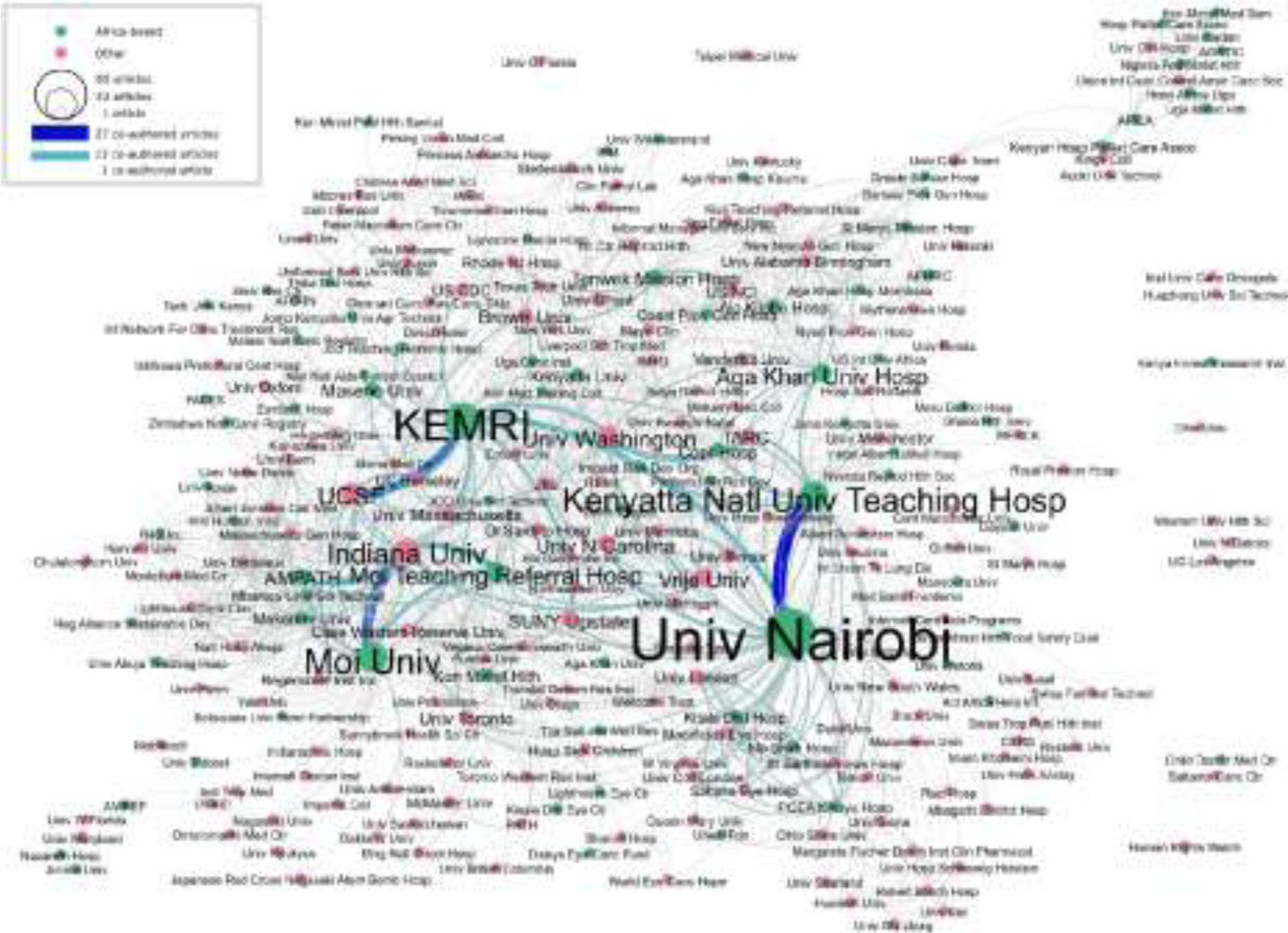
AMPATH = Academic Model Providing Access to Healthcare, USA/Kenya; Hosp = Hospital; IARC = International Agency for Research on Cancer; KEMRI = Kenya Medical Research Institute; Ken Minist Hlth = Kenya Ministry of Health; SUNY Upstate = State University of New York Upstate, USA; Univ = University; UCSF = University of California San Francisco, USA; Univ N Carolina = University of North Carolina, USA;
The author names shown in Figure 3 delineate collaborations between authors regardless of institution. Dense clusters indicate strong publishing relationships between individuals. The strongest connections occurring at 10 or more co-authored articles are represented by the thickest and darkest blue lines. A number of authors in this dataset only collaborated once as illustrated by a single thin, light grey line.
Figure 3:
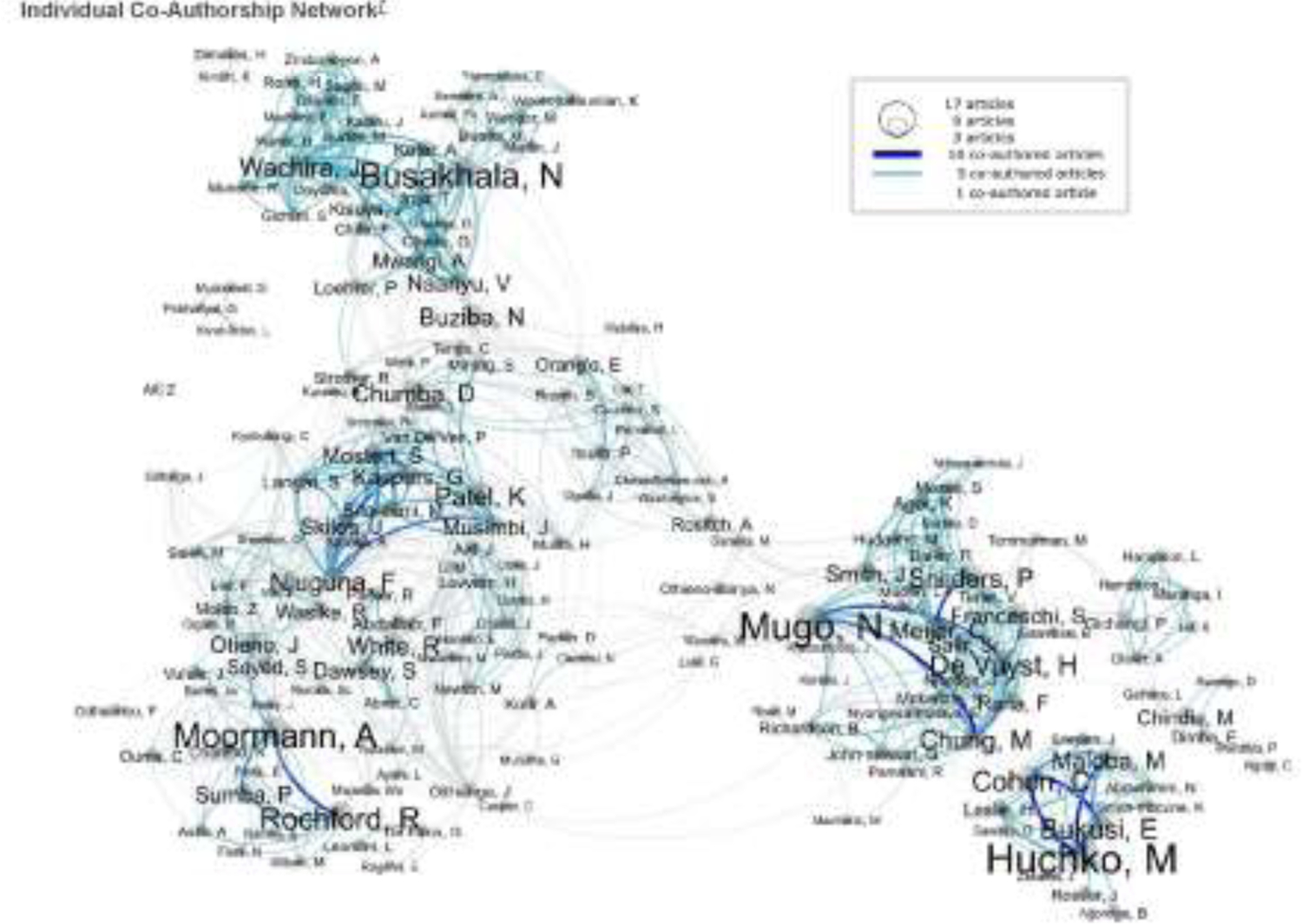
Individual Level Co-Authorship Network
Of the 15 authors with the highest number of co-authored publications (representing approximately two-thirds of total publications), 8 authors are from Kenyan-based institutions (Bukusi, E, Busakhala, N, Buziba, N, Chumba, D, Mugo, NR, Njuguna, F, Patel, K, Wachira, J), 5 are from US-based institutions (Chung, MH, Cohen, C, Huchko, M, Moormann, A, Rochford, R), and 2 are from European-based institutions (De Vuyst, H, Snijders, P).
Funding
157 articles in this study received and/or acknowledged support from various grants and funding agencies. Of these 157 articles, a total of 134 funding agencies were acknowledged, including 27 Africa-based agencies and 107 outside of the Africa region.
Approximately 90% (120) of funding agencies demonstrated cross collaboration through co-funding of research presented in the articles in this analysis, while the other 10% (14) of funding agencies were sole funders of research presented in the articles in this analysis. The top co-funding agencies included five US National Institutes of Health (NIH) institutes and centers: National Cancer Institute (NCI) (51), National Institute of Allergy and Infectious Disease (NIAID) (41), the former National Center for Research Resources (NCRR) (17), National Center for Advanced Translational Sciences (NCATS) (15), and the Fogarty International Center (FIC) (14). The Kenyan Ministry of Education, Science, and Technology was listed as the source of funding for 5 articles. NCI and NIAID were listed as funding sources on 24 articles and were the two funding sources listed together most frequently. Additionally, other pairs of NIH institutes and centers were listed together on 13 articles as sources of funding on the same article (FIC-NIAID, FIC-NCI, NCRR-NCI, NCRR-NIAID, NCATS-NCI, NCATS-NIAID) (Figure 4).
Figure 4. Institutional Level Funding Agency Collaboration.
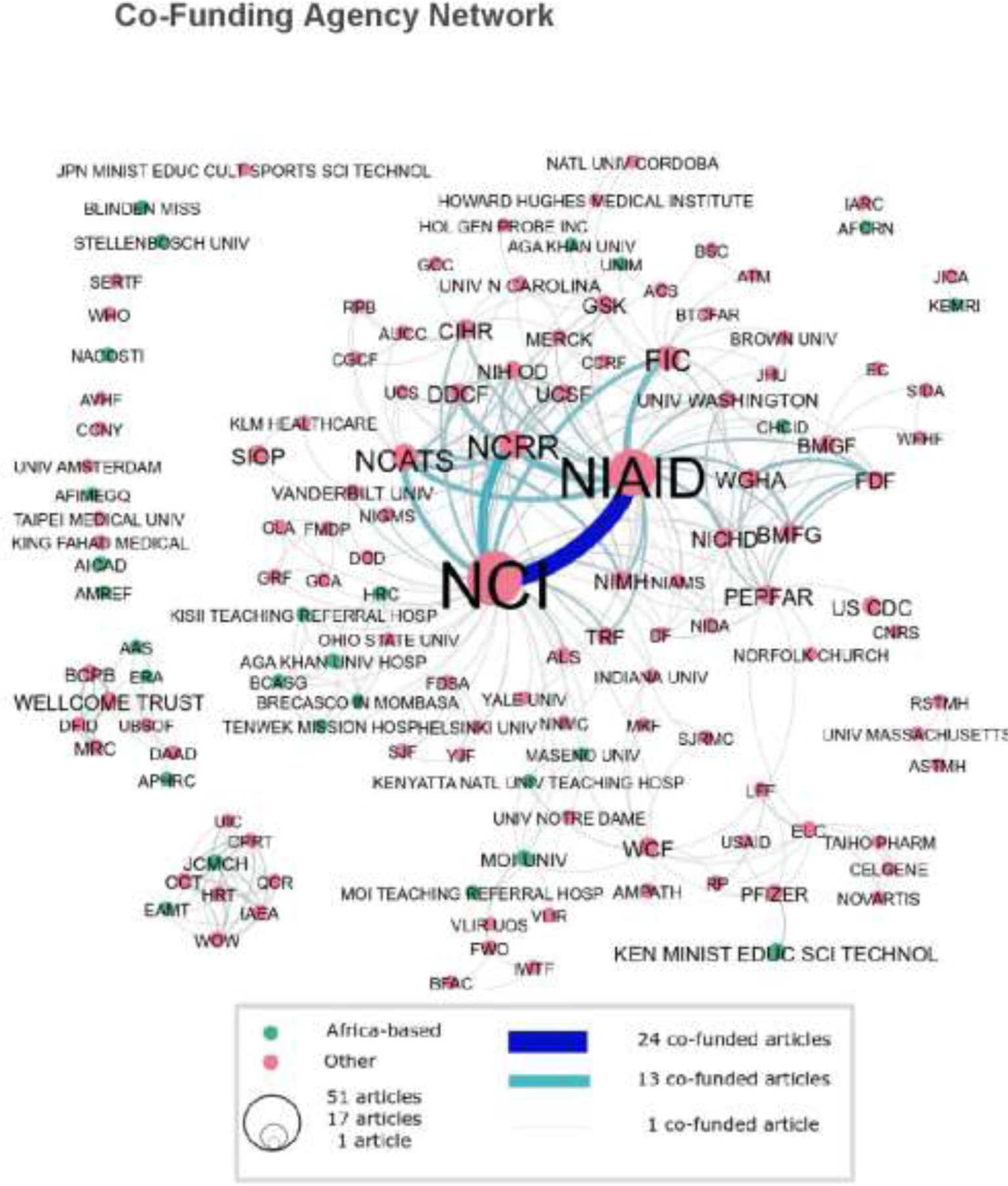
Top 5 funding agencies were all NIH institutes/centers: National Cancer Institute, National Institute of Allergy and Infectious Diseases, National Center for Research Resources, National Center for Advanced Translational Sciences, and the Fogarty International Center.
Research Topics
The major MeSH terms were analyzed to identify the primary focus of the included articles. Only 66% (161) of 243 articles in our dataset are indexed with MeSH terms, thus the results are not comprehensive. Figure 5 shows the number of articles per year per major MeSH terms (i.e., number in each cell represents article count per major MeSH topic per year). Only major MeSH topics that appeared in at least 5 articles are displayed. An article will have a maximum of five major MeSH terms, thus the number of major MeSH terms will be greater than the number of articles in the dataset. This heat map of major MeSH terms shows trends in research topics over time and gaps where none or few articles are published per year or overall, for the time period of interest. Within our dataset, the major MeSH terms with the most articles were cervical neoplasms (60 articles), HIV-associated cancers (43), neoplasms and neoplasm proteins (29), papillomavirus infections (24), and health attitudes (21). Since 2011, cervical neoplasms and HIV-associated cancers were the research topics most published on and peaked in 2014 with 14 articles and 9 respectively. Interestingly, high burden cancers in Kenya (e.g., breast and esophageal cancers) only appeared as the major focus in 9 articles.
Figure 5:
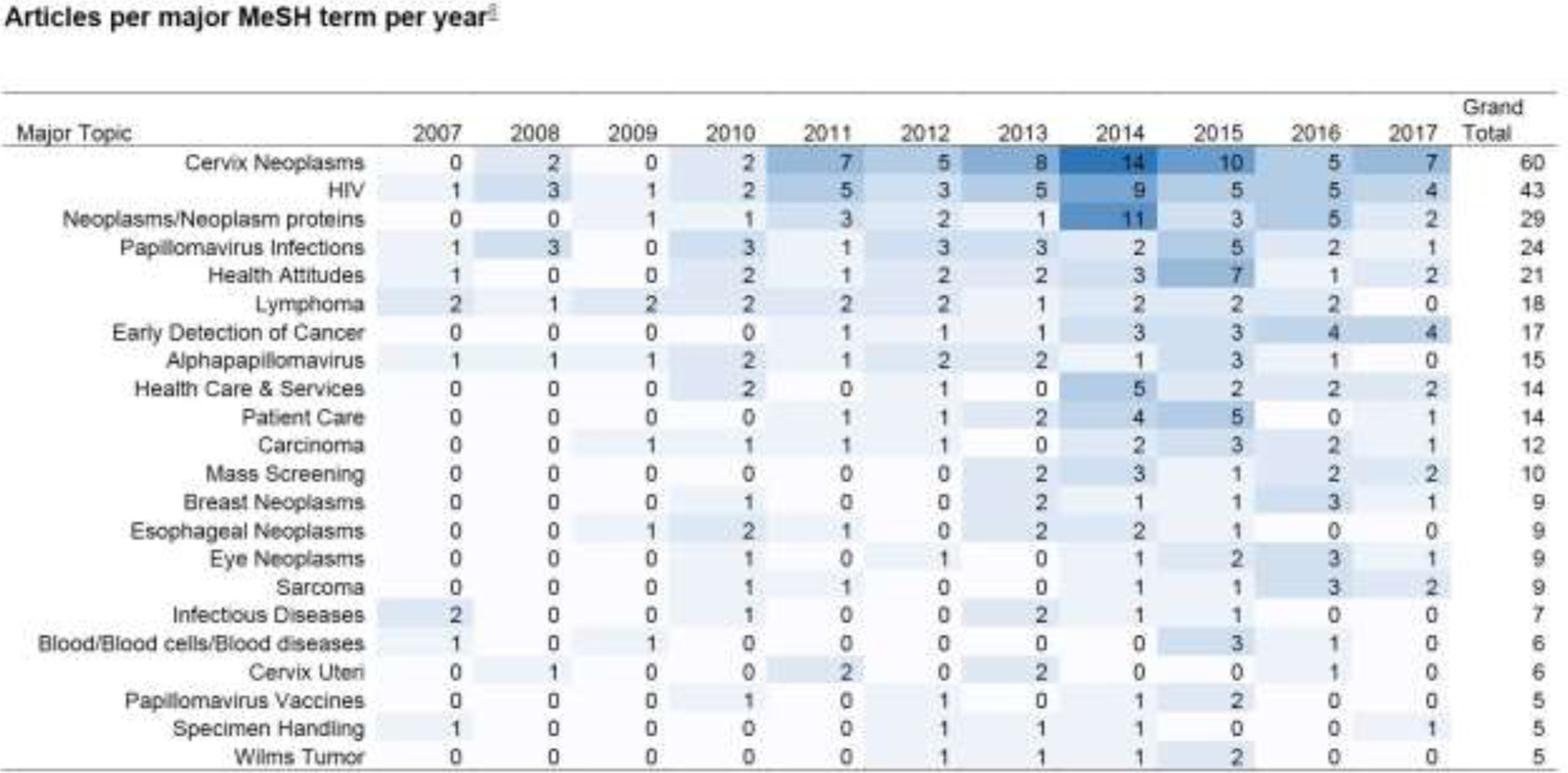
Articles Per Major Mesh Term Per Year
DISCUSSION
Our bibliometric analysis provides insights on the interconnections between the institutions conducting and publishing cancer articles, the agencies and organizations funding this research, topics of these articles over time, and the network of researchers working in oncology in Kenya. The analysis shows a steady increase in the number of articles on cancer in Kenya published per year from 2008 to 2014, with a peak in 2014 and a decline to 2017 (Supplemental Figure 1). This increase in the number of publications during the study period adds to the existing evidence base and can be used to further inform prevention, diagnosis, prognosis, treatment options, and palliative care management of cancer.
Institutional Co-Authorships
Institutional or organizational co-authorship is common in oncology research, and these networks or relationships between authors and institutions should continue to be nurtured by institutions, funders, and governments. Sustaining the existing collaborations and relationships highlighted in these analyses and establishing new ones are critical for building, strengthening, and sustaining the research infrastructures and capacities of institutions, individual researchers, and the research itself for the future. A high burden of cancer and gaps in cancer research and on the types of cancer studied are a few areas where collaborations can be important and useful to share ideas and approaches, areas of expertise, and together address the magnitude and scope of the gaps. Two Kenyan-based institutions had the highest number of co-authored papers, followed by two pairs between one Kenyan and one US institution. However, in general, there was a higher frequency of co-authorship by authors from non-Kenyan institutions.
The three pairs with the highest co-authored papers may provide some insight on impact of these partnerships the publishing roles of their institutional authors. For example, the College of Health Sciences of the University of Nairobi is housed within the Kenyatta National Hospital (KNH) and has a memorandum of understanding (MOU) that ensures the partnership and collaboration of the two institutions in various aspects of healthcare delivery. This MOU likely encourages institutional co-authorships and research between the two institutions. An example of a longer-term partnership is between KEMRI and the University of California-San Francisco (UCSF). These two institutions since 2004 have engaged in a collaborative research venture through the UCSF AIDS Research Unit and the Family AIDS Care and Education Services (FACES) program in Kisumu county. A further example is the partnership formed between Moi University and Indiana University in 1990 and the joint formation of AMPATH in 2001; additionally the Indiana University Center for Global Health coordinates the involvement of other North American institutions with the Moi University and Moi Teaching and Referral Hospital. Through these collaborations researchers frequently collaborate and publish together. The long-term nature of these partnerships has allowed researchers to work together and establish on-going relationships and partnerships which have likely resulted in multiple articles authored by researchers from the institutions.
Further analysis is needed to identify additional factors (e.g., duration and level of institutional partnership, existence of mentorship opportunities, level of long-term funding) that may contribute to high levels of co-authorships between institutions engaged in partnerships or research collaborations and conducting research in Kenya.
Individual Co-Authorships
In these bibliometric analyses, many different institutions published the majority of the articles. Of the 15 individual authors with the highest number of publications, over half (8) were from Kenyan-based institutions (AMPATH, KEMRI, Kenyatta National Hospital, Moi University, and Moi Teaching & Referral Hospital). Many of these institutions have long-term partnerships with US-based institutions and are established research institutions in Kenya, and which may demonstrate a potentially growing level of involvement and leadership by Kenyan-based researchers in the overall oncology research output conducted in Kenya.
Co-Funding Agencies
Overall, there were more than 100 funding sources used to conduct cancer research in Kenya. However, we found the primary funders of cancer research in Kenya were US-based government agencies or foundations, with the US NCI and NIAID listed 24 times as the co-funders or single funder. It was also interesting to determine which funding sources were most often listed together which may indicate potential future co-funding opportunities and to see the range of funding researchers received for the published research. As represented by the multiple single green and pink dots in Figure 4, there were many different funders listed as the funding source for a single publication. This may indicate funding for a specific researcher or discrete research project; however, further investigation into those publications would be needed.
As cancer prevalence and incidence continues to increase in Africa, funding for cancer research in Kenya and the Africa region continues to be a dominant need and should be prioritized even while global health funding entities and governments respond to the current COVID-19 pandemic. The Government of Kenya may utilize the data presented in this publication to reach out to and consult with the US NIH and other non-Kenyan research funding agencies as an opportunity to continue and strengthen these partnerships, and to learn about funding mechanism structures to guide Government of Kenya investment in biomedical and translational research to ensure that locally identified cancer research priorities are funded. This includes understanding the full landscape of existing and potential funding sources within the Government of Kenya and non-governmental Kenyan institutions to support locally relevant and needed cancer research.
Additional analyses for more in-depth reflection on equity in research funding include looking at the number of grants awarded directly to Kenyan researchers and by which funding agency, the gender distribution of awarded grants, and the institutional affiliation of grant awardees, to name a few.
Article Characteristics
Most articles were published in the regional medical journal, East African Medical Journal, which is not currently indexed in any of the major biomedical databases (PubMed/MEDLINE, Scopus, or Web of Science). Therefore, it is more difficult for other researchers to find and access articles published in this journal, particularly by those not familiar with it. It also results in decreased citation counts as other researchers are less likely to cite articles published in the East African Medical Journal because they are not easily found. To increase findability and citability, support could be provided to African-based regional biomedical journals to strengthen their infrastructure and editorial and publishing processes, assist in applying to major biomedical databases to have their content indexed, and to encourage the research published to be accessible through open access models, when feasible.
Regarding publication trends, the years 2014 and 2015 is the period with the highest number of publications in the dataset, followed by a decline from 2016 to 2017. The reasons for this decline are not clear nor confirmed; however, there may have been a decline in funding, decrease in articles published in journals indexed in PubMed/MEDLINE or Web of Science, or decline in publications by or with Kenyan cancer researchers. Nevertheless, our overall analyses do provide useful information about publication trends, types of articles, and journals most frequently published in by researchers conducting cancer research in Kenya. This information may be useful to funders and the Kenyan Ministry of Health to invest in strengthening regional medical journals, to encourage researchers to publish in journals indexed by the major biomedical databases, and to publish original research articles and case reports.
As identified by the major MeSH terms applied to the included articles, the most frequently published topics were cervical cancer, HIV-associated cancers, neoplasms, and papilloma infections. While these are some of the most prevalent cancers in Kenya, high burden cancers such as breast and esophageal cancer were the focus of fewer studies. However, one-third of our articles were not indexed in PubMed/MEDLINE and did not have MeSH terms, which may explain why the high burden cancers in Kenya are not reflected in our results or Figure 5. Further investigation is warranted to determine whether there truly is a gap between some of the high burden cancers in Kenya (breast, colorectal, esophageal, prostate)[6] and the types of cancers published on in Kenya.
Within our dataset, the predominant cancer care delivery areas based on major MeSH terms were early detection, healthcare services, and patient care. Since early detection is key to effective management of cancer [9], this is an important area to increase attention and publishing. Additional care delivery areas that may require increased research include effective referral systems, barriers to access, provider recommendations, patient’s ability to pay, and patient inclusion in decision-making [10]. Funders and the Kenyan Ministry of Health may consider ways to encourage researchers to publish their work on these specific topics (e.g., requirements in awards, writing support and training, mentoring, etc.) and possibly direct funding to these specific care delivery areas.
Limitations
The main study limitation is that the analysis was based on articles published from 2007 to 2017 and does not include articles published after 2017. Thus, these findings are not a comprehensive picture of all or the most recently published cancer research conducted in Kenya. However, these analyses do provide interesting insights into future opportunities for funders and the Kenyan Ministry of Health regarding specific research areas to focus and to build and support research mentorships or apprenticeships and capacity building for writing and publishing. Finally, as our bibliometric analysis relied upon using PubMed/MEDLINE and Web of Science, some articles from the original scoping review dataset were excluded as they were not found in the above databases and thus information on co-authors and their affiliations, funding sources, MeSH terms, and other metadata were not available.
CONCLUSION AND POLICY SUMMARY
This bibliometric analysis provides a preliminary view into individual, institutional, and national achievements in cancer research in Kenya, and highlights partnerships and trends in funding and research from 2007 to 2017. The analysis identifies trends in cancer research publications, the years of highest publication output, and the extent to which the cancer research topics are aligned to the local burden of disease. The co-funding network analysis provides an opportunity for funders and governments to sustain and build upon the existing research networks and to pursue local and other international collaborations to further cancer research in Kenya. In Table 1 we include a series of recommendations for future research and analyses to delve deeper into some of the key themes and areas identified in this article. These analyses can inform and be used as part of an overall national research agenda to guide policy development, research planning, funding, evidence-based- decision making, and priority areas for future research in Kenya.
Table 1:
Recommendations for future research
| Conduct additional analyses to understand the factors that contribute to successful and sustained long-term research collaborations and co-authorships, and the resulting outcomes of long-term partnerships. |
| Perform a landscape analysis of funding sources from within Kenya and internationally to develop sustained cancer research infrastructure in Kenya. |
| Conduct additional sub-analyses on research grant awards and authorship, including number of direct awards to Kenyan investigators, distribution by gender, institutional affiliation, funding source, and other key fields. |
| Promote increased opportunities for open access publishing for cancer researchers in Kenya and the African region and increased visibility of Africa-based regional biomedical journals. |
| Develop a research agenda for Kenya that includes focus on high burden cancers not currently studied and healthcare delivery research. |
Supplementary Material
HIGHLIGHTS.
During the time period 2007–2017, United States government agencies funded the majority of published cancer research conducted in Kenya;
Existing partnerships between Kenya-Kenya and Kenya-US-based institutions were the predominant institutional collaborations publishing the majority of articles during the time period;
Kenya-based authors represented half of the most prolific authors during this period of time.
FUNDING
This work was supported by the intramural research program of the National Institutes of Health and National Cancer Institute.
Footnotes
Publisher's Disclaimer: This is a PDF file of an unedited manuscript that has been accepted for publication. As a service to our customers we are providing this early version of the manuscript. The manuscript will undergo copyediting, typesetting, and review of the resulting proof before it is published in its final form. Please note that during the production process errors may be discovered which could affect the content, and all legal disclaimers that apply to the journal pertain.
Declarations of interest: none
References
- [1].GLOBOCAN 2020, International Agency for Research on Cancer, Fact Sheet: All Cancers: 2020: Number of new cases in 2020, both sexes, all ages, 2020. https://gco.iarc.fr/today/data/factsheets/cancers/39-All-cancers-fact-sheet.pdf. (Accessed July 15 2021).
- [2].Fidler MM, Bray F, Soerjomataram I, The global cancer burden and human development: A review, Scand. J. Public Health 46(1) (2017) 27–36. 10.1177/1403494817715400 [DOI] [PubMed] [Google Scholar]
- [3].International Agency for Research on Cancer, Global Cancer Observatory: Estimated number of new cases from 2020 to 2040, Both sexes, age [0–85+], 2020. https://gco.iarc.fr/tomorrow/en/dataviz/bubbles?sexes=0&mode=population. (Accessed October 12 2021).
- [4].Morhason-Bello IO, Odedina F, Rebbeck TR, Harford J, Dangou JM, Denny L, Adewole IF, Challenges and opportunities in cancer control in Africa: a perspective from the African Organisation for Research and Training in Cancer, Lancet Oncol. 14(4) (2013) e142–51. 10.1016/S1470-2045(12)70482-5 [DOI] [PubMed] [Google Scholar]
- [5].United Nations Development Programme, Human Development Report 2020, United Nations Development Programme, New York, NY, 2020. http://hdr.undp.org/en/2020-report. (Accessed June 30, 2021). [Google Scholar]
- [6].GLOBOCAN 2020, International Agency for Research on Cancer, Fact Sheet: Kenya: Number of new cases in 2020, both sexes, all ages, 2021. https://gco.iarc.fr/today/data/factsheets/populations/404-kenya-fact-sheets.pdf. (Accessed July 15 2021). [Google Scholar]
- [7].Manduku V, Akhavan M, Asiki G, Brand NR, Cira MK, Gura Z, Kadengye DT, Karagu A, Livinski AA, Meme H, Kyobutungi C, Moving towards an evidence-informed cancer control strategy: A scoping review of oncology research in Kenya, J. Cancer Policy 24 (2020) 100219. 10.1016/j.jcpo.2020.100219 [DOI] [Google Scholar]
- [8].US National Library of Medicine, Medical Subject Headings (MeSH) in MEDLINE/PubMed: A Tutorial: Major Topics. https://www.nlm.nih.gov/bsd/disted/meshtutorial/principlesofmedlinesubjectindexing/majortopics/index.html. (Accessed June 30 2021).
- [9].Tobore TO, On the need for the development of a cancer early detection, diagnostic, prognosis, and treatment response system, Future Science OA 6(2) (2019) FSO439–FSO439. 10.2144/fsoa-2019-0028 [DOI] [PMC free article] [PubMed] [Google Scholar]
- [10].Mandelblatt JS, Yabroff KR, Kerner JF, Equitable access to cancer services, Cancer 86(11) (1999) 2378–2390. [DOI] [PubMed] [Google Scholar]
Associated Data
This section collects any data citations, data availability statements, or supplementary materials included in this article.



